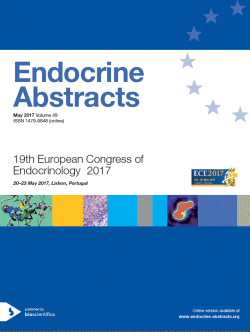
19th European Congress of Endocrinology
Lisbon,
Portugal
20 May 2017 - 23 May 2017
Oral Communications
Neuroendocrinology
ea0049oc8.1 | Neuroendocrinology | ECE2017
Elucidating the molecular mechanisms underlying AIP dependent tumorigenesis
Bogner Eva-Maria , Daly Adrian F. , Beckers Albert , Atkinson Michael J. , Pellegata Natalia S.
ea0049oc8.2 | Neuroendocrinology | ECE2017
Knocking down/out the prokineticin pathway during zebrafish development results in the GnRH neurons axons misguiding
Bassi Ivan , Marelli Federica , Vezzoli Valeria , Persani Luca , Gothilf Yoav , Bonomi Marco
ea0049oc8.3 | Neuroendocrinology | ECE2017
RNA sequencing and RT-qPCR identify different gene expression profiles in fast- vs. slow-growing non-functioning pituitary adenomas
Falch Camilla Maria , Sundaram Arvind Y.M. , Oystese Kristin Astrid Berland , Normann Kjersti Ringvoll , Silamikelis Ivars , Andersen Marianne , Bollerslev Jens , Olarescu Nicoleta Cristina
ea0049oc8.4 | Neuroendocrinology | ECE2017
Cerebrovascular stroke incidence in GH-treated adults: experience from KIMS (Pfizer International Metabolic Database)
Camacho-Hubner Cecilia , Cara Jose , Mattsson Anders
ea0049oc8.5 | Neuroendocrinology | ECE2017
Ephrin-B2 is required for pituitary development
Jimenez Fernando , Gualtieri Angelica , Scagliotti Valeria , Gaston-Massuet Carles



